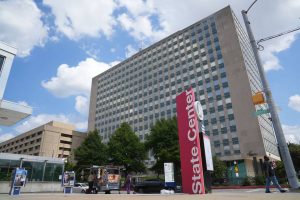
The City planning department’s late February open house for nearby residents to provide input on what to do with the soon-to-be-abandoned 18-acre State Center on Bolton Hill’s south border was, some would say, a nothing-burger.
There was no program, no presentation by city officials and no organized conversation about what might occupy or replace the six decrepit office buildings once they are vacated next year. Instead, the roughly 100 adults who showed up were given colored stickers and directed to mill around a series of white boards to rate broad possible choices for development. Many from Bolton Hill who attended on that rainy night called it time and city resources wasted.
But in a subsequent call with a city official, who asked not to be quoted, here is what we learned:
- Although the state still controls the property, the city Department of Planning shelled out more than $300,000 for a six-month market study of possible uses for the tract, one of the larger central city parcels available in any major city. None of the market study consultants attended the open house. Their report is due in July and will be made public. That study could become the basis for a subsequent outreach to developers and institutions to explore their interests.
- That study and the reaction to it could determine whether the existing office buildings, built in a mid-century brutalist architecture style, will stay, be modified, or go. Earlier plans to rebuild state offices and add commercial development, killed by former Republican Gov. Larry Hogan, envisioned the historic State Armory as part of the development, but the state is not conveying the armory building to the city.
- Although the last of the state offices is scheduled to close late in 2025 as employees move into leased space downtown, there is no date certain for transferring control of the property from the state to the city. Many details remain to be worked out. It’s unclear, for example, who pays for site clearance or remediation and what the costs might be. Some of us worry that the city, if it assumes the cost, will have neither the imagination nor the resources to do the job efficiently.
- The site could be vacant for an undetermined amount of time – months, perhaps years – while the city figures out what to do and to find a developer with the money to move forward. The city wants to minimize vacancy time that could invite graffiti, squatters, and other undesirable activities.
- Obvious possible uses include an educational or health care facility or new office buildings if, for example, a large enterprise wanted to move its headquarters there. Housing of some sort – apartment buildings, townhouses, and/or low-income residences is probable. Commercial development centered around a Home Depot or other big store and/or smaller businesses and green space also are likely considerations. A study commissioned by the former governor several years ago suggested a sports arena.
- The city wants to build on the site as a transportation hub and tie-in, if feasible, with the renovation and expansion taking place around Penn Station. State Center has a subway station, light rail service and several bus lines currently. The market study does not include a traffic analysis or projections.
- A plan that properly integrates new development into the existing neighborhoods could include new retail. Earlier plans, scrapped by Hogan, called for a supermarket and hospitality facilities blending with new state offices.
The original public-private state center redevelopment project was approved during the administration of Gov. Robert Erlich, also a Republican, nearly two decades ago. Contracts for a $1.5 billion re-development were signed, although litigation led by downtown property owners Peter Angelos and others caused long delays. Once he took office in 2015, Hogan pronounced the development a boondoggle and tried to kill it, leading to new litigation.
The emptying out of downtown during the pandemic led to a deal between state senate leader Bill Ferguson, whose district includes downtown Baltimore, and the governor to move state employees into downtown and to vacate State Center. In August 2022, the Hogan Administration announced plans to hand off the site to the city once the state agencies moved out.
Former Bolton Hill resident John Kyle, who years ago helped create and lead a multi-neighborhood coalition to collaborate with the original State Center redevelopment, said he is reaching out to those coalition participants to revitalize the State Center Neighborhood Alliance. A state law passed at SCNA’s urging required the state to seek consensus with surrounding neighborhoods around any development.
–Bill Hamilton
